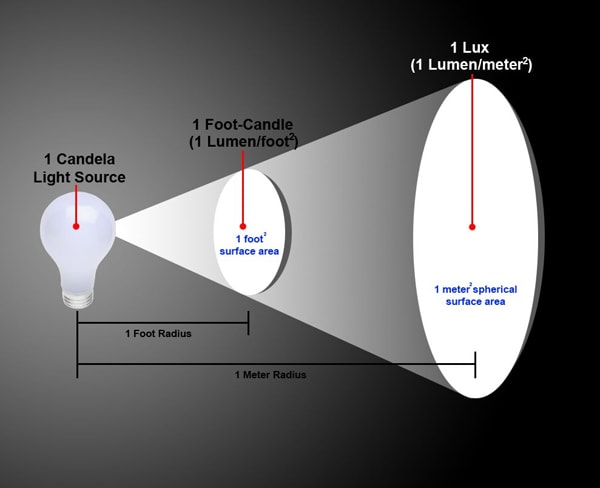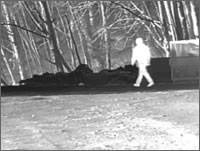Very low light optical cameras, IR illumination, and thermal cameras are options for seeing in the dark.

It was a dark night with just a small sliver of the moon shining through the trees. The mouse nosed its way through the underbrush using its nose to find small nuts and berries. Unknown to the mouse there was something watching from a tree limb high above. The owl was able to see the mouse clearly even though there was hardly any light. Poor mouse. He had no idea he was in trouble.
How does the owl see in the dark? This article describes the various ways that animals, and more importantly, video cameras can see in the dark. We discuss how cameras make use of the limited light available, IP cameras that use IR illumination and thermal cameras that use thermal imaging technologies.
Owls and other nocturnal creatures have very large eyes and have many more light receptors in their eyes than we do. This dramatically improves their night vision, but they do require some light. To better understand how IP cameras see at night let’s first review how we measure light.
Measuring Light

Lumens
A LUMEN is also a unit of measurement of light. While a foot-candle is how bright the light is, a lumen is a way of measuring how much light gets to what you want to light up! One LUMEN is equal to one foot-candle falling on one square foot of area.
For example, if we take the candle and place a book one foot away from the candle, and if that book happens to be one foot by one foot (one square foot), then all the light falling on that book equals one LUMEN!
Foot-Candles
A foot-candle measures how much light is generated from a light source. For example, if you have a birthday cake with only one candle (Happy Birthday) and stand one foot away from it you will see one foot-candle of light. Also, note that if you stand further away you see less light and if you stand closer you see more light. The power of the light is inversely proportional to the distance from the light source.

LUX
In the metric system, Illuminance is measured in Lux. It’s the light reaching an object that is 1-meter x 1-meter square. rather than the light hitting the object. One Lux equals one lumen per square meter, so this is measured in metric units rather than English units of measure. To reinforce this, LUX is the measurement of actual light available at a given distance from an object.
Illuminance is what results from the use of light. You turn your flashlight on in a dark room, and you light something up. That’s illuminance. Turning on a light in a dark room to make the burglar visible gives you illuminance. It also gives you another problem when you note the burglar is pointing your duck gun at your bellybutton.
Here are some practical examples. Typical illuminance values are:
| 0.1 – 1 lx | Full moon (depending on geographic location) |
| 10 lx | Street lighting or twilight |
| 100-1,000 lx | Workspace lighting |
| 10,000 lx | Surgery lighting |
| 100,000 lx | Sunshine |
Night-Vision, Seeing in the Dark
Seeing in the dark is actually a relative term. The mouse thinks it’s too dark to see while the owl is able to see perfectly fine at night. If there’s a full moon we can see things dimly, but if there’s no moon it’s too dark for us and the mouse to see anything.
There are three ways to improve what we see at night: We can amplify the small amount of light available with a good low light camera. We can illuminate the area using an IR illuminator or we can detect the heat levels coming off an object using a thermal imaging camera.
Low-Light Sensitivity Cameras
Cameras with good low light sensitivity are just like the owl. They are able to see even when it’s too dark to see with our own eyesight.
The owl and all other nocturnal animals have big eyes. So cameras with good night time vision use lenses that accept as much light as possible. Lenses with an f-number of 1.4 or lower allow a lot of light to get to the camera’s sensor. The lower the f-number, the more light can get through the lens, so it’s a good idea to select a lens with the lowest f-number available.
Low-light cameras also have very good image sensors. Usually, the larger the sensor the more light is detected, but the latest sensors are extremely good at picking up the light. Low-light IP cameras are able to switch from color to monochrome to improve light sensitivity, and they do a good job of amplifying the available light.
The owl was able to see even when there was hardly any moonlight. A full moon provides about 0.1 lux of light so if we want to see as well or better than the owl, we need to have a camera with a low light sensitivity of less than 0.1 lux. Good low-light cameras operate at very low light levels. For example, the XNO-6085R bullet IP camera has a color low-light sensitivity of 0.004 lux. It includes an IR illuminator and switches to monochrome (BW). Cameras that can see at this very low light have to increase the video amplification dramatically. Unfortunately, at the limit of their amplification electrical noise is introduced, so it’s likely to get fuzzy images at this very low light level.
IR Sensitive Cameras
Day/night cameras not only can operate at low light levels, but they are also sensitive to IR illumination. IR stands for infrared which means below red (lower frequency). It is similar to standard light except it is below the visible red light that we can see. The wavelength of this light is between 700 and 1400 nm.
Day/night cameras usually have filters that control IR light entering the camera sensor. During the day the IR light is blocked because it affects the color. When it’s dark and the camera switches to monochrome (or BW) mode, the filter is removed to allow the IR light to hit the camera sensor. The camera also requires a lens that doesn’t block the IR light.

For an IR camera to work you need IR illumination. We can always use an external IR illuminator, but some cameras have the IR illumination built-in. For example, the Hanwha SNP-6320RH, PTZ IP camera has an IR illuminator that allows the camera to see without any other light source within a distance of 490 ft. (150M). IR light is absorbed by the water in the air so it doesn’t have a very long range. To get ranges of over 500 ft. we use special laser light sources with focused beams.
An IR sensitive camera is usually used when you don’t want people to know you are viewing them. The IR light is not visible so just like the mouse; they don’t know they are being watched.
Thermal Imaging Cameras
Thermal imaging or thermographic imaging cameras are able to see when there is absolutely no visible light. They go beyond the capability of the owl. An owl or night vision device acquires what little light is available from the moon or stars and amplifies that light to allow it to see at night. If there is no light available, then the night vision device will not work. Only a thermal imager can see in absolute darkness.

These cameras are sensitive to heat radiation that comes from an object that’s warmer than the surrounding environment. They can see the heat coming from a person or animal. Thermal imaging cameras can detect emitted energy through smoke, dust, fog, blowing sand, rain, and snow. Visible light wavelengths bounce or are reflected off the obscurant particles due to the wavelength being short. The long wavelength of the infrared spectrum can pass through obscurants allowing a thermal imager to detect the emitted energy.
Thermal imaging cameras are sometimes referred to as FLIR (Forward Looking InfraRed) cameras. The name came from the military application of placing a camera on the front of an airplane (forward-looking).
The resolution of thermal imaging cameras is considerably lower than that of optical cameras. Thermal cameras have a resolution of 320x 240 or 640 x 480 pixels. These thermographic cameras are much more expensive than their visible-spectrum counterparts, and higher-end models are often export-restricted. The newest technologies use low cost and uncooled micro-bolometers FPA sensors. A micro-bolometer is a specific type of bolometer used as a detector in a thermal camera. Infrared radiation with wavelengths between 8-13 μm strikes the detector material, heating it, and thus changing its electrical resistance. This resistance change is measured and processed into electrical signals which can be used to create an image. Unlike other types of infrared detecting equipment, micro-bolometers do not require cooling.
Thermal imaging cameras require a special lens that works at this light frequency. Germanium is most widely used for lenses and windows in IR systems operating in the 2 µm – 12 µm range. Standard lenses block the thermal light while germanium lenses are transparent to this spectrum of light. These lenses are expensive and take a long time to make.
For an example of various cameras that can be used at night, take a look at our Long Range Night Vision Cameras. Thermal imaging cameras are much more expensive than standard cameras with prices starting at around $10,000 and can be as high as $60,000 or more.
Low-Light Cameras Summary
Cameras with very good light sensitivity can see things the human eye can’t see; they can even see better than the owl. By adding IR illumination the camera can see when there’s no visible light. Thermal imaging or thermographic cameras can see without any light at all, using the thermal energy coming from a heated object.
In general, if there is some light it’s best to use a camera with good low-light sensitivity. If there is no light, you can add IR illumination, but the least expensive solution is to add standard lights. IR illumination is added only if you don’t want the person to know that they are being watched. A thermal imaging camera is usually used by the military because it is best for very long-distance detection.
So if you want to learn more about how to see as well as an owl, please contact us at 914-944-3425, or by completing the contact form.